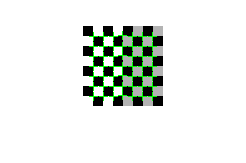detectMinEigenFeatures
Detect corners using minimum eigenvalue algorithm
Description
points = detectMinEigenFeatures(I)cornerPoints object points
that contains information about corner features detected in the 2-D grayscale or binary
input using the minimum eigenvalue algorithm developed by Shi and Tomasi.
points = detectMinEigenFeatures(I,Name,Value)
Examples
Input Arguments
Name-Value Arguments
Output Arguments
References
[1] Shi, J., and C. Tomasi, "Good Features to Track," Proceedings of the IEEE Conference on Computer Vision and Pattern Recognition, June 1994, pp. 593–600.
Extended Capabilities
Version History
Introduced in R2013a
See Also
Functions
detectSURFFeatures|detectBRISKFeatures|detectFASTFeatures|detectHarrisFeatures|detectMSERFeatures|detectKAZEFeatures|detectORBFeatures|extractFeatures|extractHOGFeatures|detectFASTFeatures|matchFeatures
